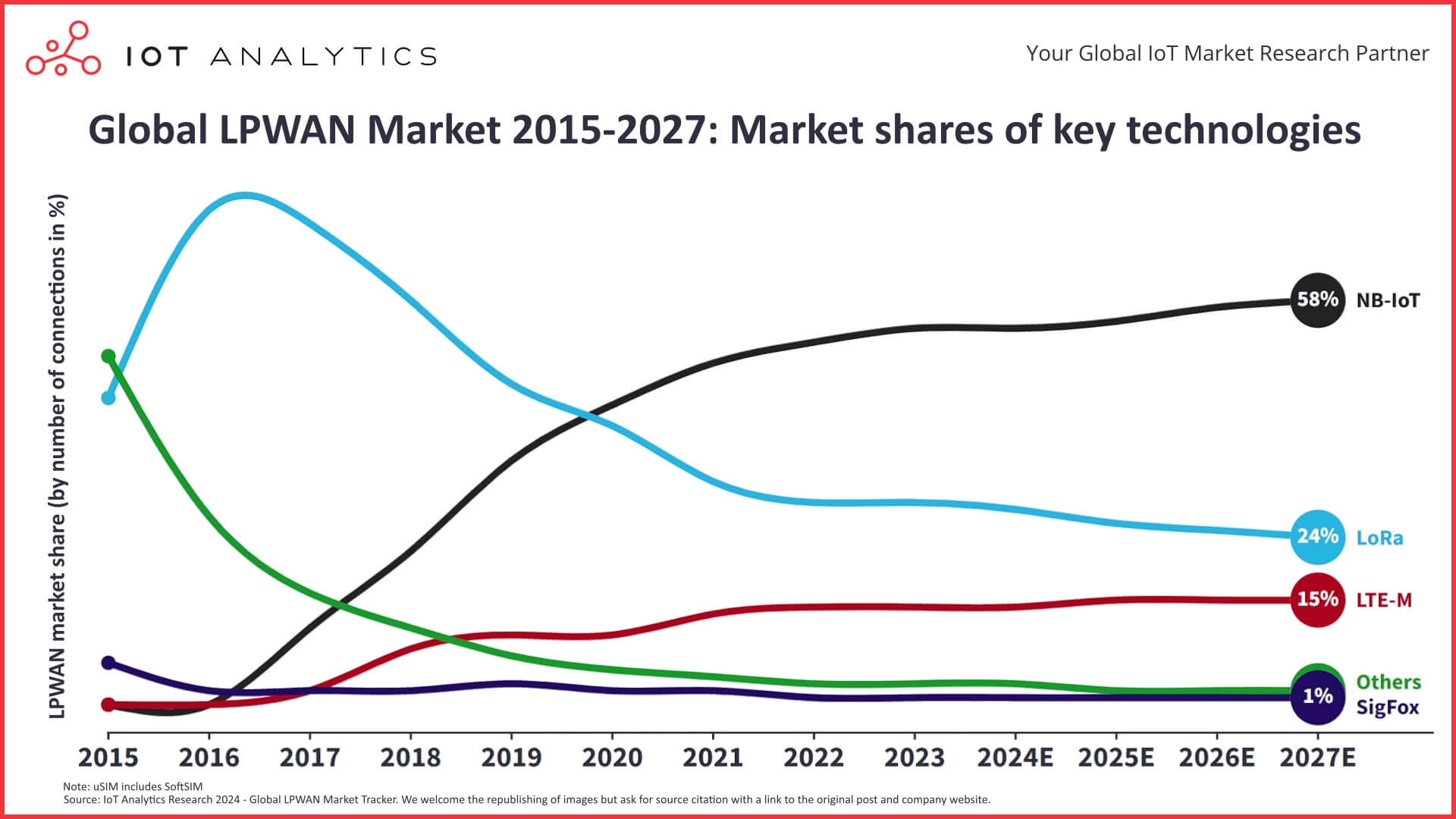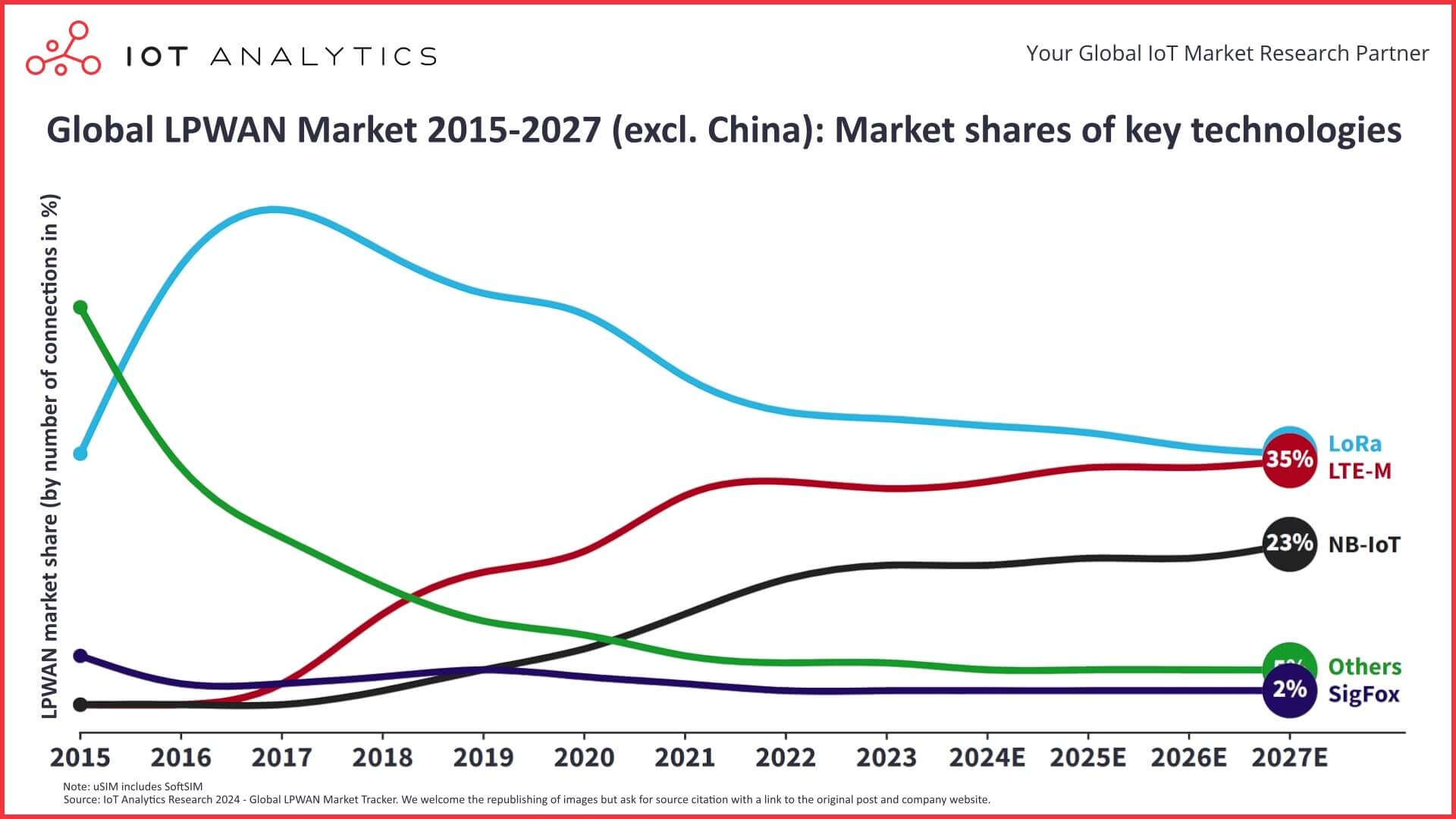

IoT Analytics has published a new analysis that provides an overview and insights into the LPWAN market in 2024.
This analysis is derived from the “Global LPWAN Market Tracker and Forecast 2015-2027 (Q1/2024 Update)” – a tracker that includes market data on worldwide LPWAN connections and module shipments from 2015 to Q4 2023, including market projections for 2024 to 2027.
Key Insights:
- LPWAN connectivity is on the rise. There were nearly 1.3 billion LPWAN IoT connections globally by the end of 2023, according to IoT Analytics’ Global LPWAN Tracker and Forecast 2015–2027 (updated Q1 2024). This is expected to grow at 26% CAGR until 2027.
- NB-IoT comprises 58% of these connections. However, that does not tell the whole story about NB-IoT’s global adoption, as China’s nationwide adoption policy has greatly skewed this number.
- In 2023, licensed LPWAN connections surpassed unlicensed LPWAN connections, even when excluding China’s saturation of NB-IoT, a licensed LPWAN connectivity technology.
Key Quotes:
Knud Lasse Lueth, CEO at IoT Analytics, remarks: “In less than a decade, LPWAN technology has transformed from a nascent market into 1.3 billion connections. This remarkable growth, propelled by both licensed and unlicensed LPWAN technologies, underscores the critical role of low-power wide-area connections in powering IoT applications across diverse industries. At IoT Analytics, our dedication lies in delivering precise, actionable insights that empower stakeholders to adeptly navigate the rapidly evolving IoT connectivity landscape.”
Satyajit Sinha, Principal Analyst at IoT Analytics, adds that:
“LPWAN technology is evolving rapidly. Integration with satellite IoT connectivity is a natural progression in the field and will likely pave the way for new applications and connect previously unconnected things. Both NB-IoT and LoRa technologies have important roles to play in this hybrid connectivity model, enhancing the efficiency and reach of IoT applications.”

LPWAN Market overview
There are nearly 1.3 billion LPWAN IoT connections globally, according to IoT Analytics’ Global LPWAN Tracker and Forecast 2015–2027 (updated Q1 2024), which tracks LPWAN market data at a granular level across regions, industries, and types. This represents approximately 8% of the over 16 billion connected IoT devices worldwide in 2023.
The LPWAN tracker forecasts that the number of LPWAN connections will grow at a 26% CAGR until 2027, reaching 3 billion at that time, or 10% of all IoT connections worldwide. Behind this growth is the need for use cases like remote monitoring that require infrequent data transmission and battery operation, which LPWAN is especially suited.
Low-power wide-area network (LPWAN) is a set of wireless communication technologies and protocols designed for power-efficient, long-range, and low-cost communication for simple IoT devices. LPWAN technologies are aimed at IoT applications that require the transmission of small amounts of data over long distances and/or to gather information from hard-to-reach locations (e.g., deep underground or remote areas) from battery-operated devices that can operate for several years without any human intervention, with minimal device and connectivity costs.
LPWAN can be on licensed spectrums (e.g., LTE-M and NB-IoT), where a network uses dedicated frequencies for connections, and unlicensed spectrums (e.g., LoRa), where a network does not use dedicated frequencies.
The tracker shares granular LPWAN market data across regions, industries, and technology types, including revenue, shipments, and connections. Here, we will look at three insights from the tracker that merit context, as discussed below:
-
1. China’s “Big Connectivity” strategy skews global LPWAN connection data
2. LoRa remains the leading LPWAN technology outside of China
3. Licensed LPWAN connectivity technology surpassed unlicensed in 2023, even when excluding China’s weighted adoption rate
Market insight 1: China’s “Big Connectivity” strategy skews global LPWAN connection data

Globally, NB-IoT has the largest share of LPWAN connections at approximately 54%. However, this does not paint a clear picture of the world’s adoption of this LPWAN technology.
In 2016, China—the world’s most populated country—made the nationwide rollout of NB-IoT part of its “Big Connectivity” strategy for 2016 to 2020 to support a wide range of use cases. One such use case is smart metering, in which China is a regional leader in adopting smart gas and water meters. According to the LPWAN tracker, by 2023, ~81% of all LPWAN connections in China were NB-IoT, and the country accounted for ~84% of all global NB-IoT connections.
The following charts help demonstrate the impact of China’s dedicated adoption of NB-IoT on global LPWAN connections. On the top chart, we see NB-IoT’s share of LPWAN connections skyrocket between 2016 and 2023—the timeframe for China’s “Big Connectivity” strategy. However, on the bottom chart, China’s LPWAN data are excluded from the global totals, and NB-IoT’s climb—while significant—is nowhere near as pronounced. By the start of 2024, LoRa had a sizeable lead over the other technologies.

This does not mean NB-IoT is not gaining steam elsewhere, however. As the bottom chart shows, when excluding China, NB-IoT comprised 20% of LPWAN connections in 2023—a quick climb since its 3GPP standardization in June 2016. By 2027, the LPWAN tracker forecasts NB-IoT to reach 23% of China-excluded global LPWAN connections, while LoRa is expected to maintain its lead at 36%.
Interesting new use cases are helping drive NB-IoT’s increasing share of LPWAN connections. In July 2023, Spain-based low-Earth orbit (LEO) constellation satellite operator Sateliot and Spanish multinational telecommunications company Telefónica successfully tested an end-to-end roaming 5G cellular network in space using NB-IoT. In January 2024, IoT Analytics noted this test as the most innovative IoT connectivity technology development in 2023.
Market insight 2: LoRa remains the leading LPWAN technology outside of China
When excluding all LPWAN data from China, LoRa has the leading share of global LPWAN connections at 41%—more than double NB-IoT’s share.
Though LoRa’s share of LPWAN connections is decreasing, the technology’s market is still forecasted to grow at a CAGR of 17% by 2027. Helping drive this growth are smart water and gas metering applications, sustainability applications, such as agricultural resource management and optimization, and asset monitoring and tracking solutions, such as US-based semiconductor manufacturer Semtech’s LoRa Edge technology.
Market insight 3: Licensed LPWAN connectivity technology surpassed unlicensed in 2023, even when excluding China’s weighted adoption rate
According to the LPWAN tracker and forecast, licensed LPWAN technology reached a milestone in 2023: its share of LPWAN connections surpassed that of unlicensed LPWAN connections without the assistance of China’s weighted adoption of NB-IoT, a licensed LPWAN technology.
When considering China’s adoption of NB-IoT, licensed connections had already surpassed unlicensed ones by 2020. However, as shown above, NB-IoT’s share of LPWAN connections is not representative of global adoption due to China’s dedicated nationwide rollout of the NB-IoT. Now, without China’s significant boosting considered, it appears that licensed connections are on the rise worldwide and are forecasted to comprise 58% of LPWAN connections in 2027.
Helping drive the rise of licensed LPWAN are cases like smart city management. China offers a good use case with its smart meters, but there are other case studies around the world. For example, Germany-based IoT sensor and data analysis company Sentinum sought to address inefficiencies with public waste management, such as waste collection trucks driving routes where some waste bins are not full. It wanted to use LPWAN connectivity due to its low-power demands, further adding to sustainability.
Sentinum partnered with Vodafone, a UK-based global telecommunications provider, to leverage Vodafone’s licensed LPWAN (specifically, NB-IoT) to reliably relay bin fill data to Sentinum’s backend servers and alert municipal waste disposal staff what bins need collection. Vodafone notes that some applications can experience a time savings of 40% and a CO2 reduction of around 25%.
Analyst assessment: Key LPWAN trends to watch
These insights are from the updated Global LPWAN Tracker and Forecast 2015–2027, which readers can leverage for granular data across regions and industries. Later in 2024, IoT Analytics is planning to publish a full LPWAN market report, which will dive into the LPWAN market data, trends, and company insights. For now, here are two trends worth watching: 1) cooperation and convergence and 2) addressing LPWAN’s limitations.
Trend 1: Convergence and collaboration
The LPWAN industry has evolved significantly over the last decade, and the technology has become more popular. With the market maturing and taking hold within greater IoT connectivity, there appears to be a shift from the early days of high competition to an increased focus on convergence and cooperation.
For example, on July 25, 2023, US-based semiconductor manufacturer Semtech Corporation announced a collaboration with UnaBiz, a Singapore-based IoT solutions provider specialized in LPWAN connectivity, to integrate Unabiz’s Sigfox 0G technology into Semtech’s LoRa Edge and LoRa Connect platforms. This partnership aims to create a cost-effective, versatile platform by offering Sigfox technology support in Semtech’s LR1110, LR1120, and LR1121 products through Sigfox-specific APIs.
Moreover, this initiative highlights the industry’s push towards sustainable, adaptable IoT solutions, allowing customers to choose optimal connectivity based on their unique use cases and sustainability objectives. It is these solutions that will drive the market through 2027, and possibly beyond.
Trend 2: Addressing LPWAN limitations
There are still some limitations of LPWAN that need to be addressed. For example, LPWAN was designed around point-to-point connectivity, not large-scale connectivity with heavy data loads. Higer packet transmission can make LPWANs susceptible to interference from a number of sources (e.g., atmospheric/electrical noise, other radio networks, or even jamming).
To address this, transmission protocols need to ensure that complete data structures are delivered to their endpoints. One notable approach gaining attention in the LPWAN field is from mioty Alliance, a group of businesses, institutes, and engaged individuals aiming to enhance IoT connectivity solutions.
The alliance’s solution is to leverage the Telegram Splitting Multiple Access (TSMA) method to split data packets into smaller subpackets at the sensor level and transmit the packets over different frequencies and time marks. An algorithm on the receiving end will monitor for mioty subpackets and reassemble them into complete messages, ensuring complete messages are received even if one or a few frequencies are experiencing interference.
The post LPWAN market 2024: Licensed technologies boost their share among global 1.3 billion connections as LoRa leads outside China appeared first on IoT Business News.








